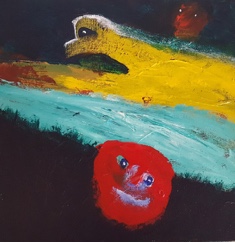“Telling our Stories: Art and Homelessness” highlights the vision of resident artists living at the Downtown Emergency Service Center building located at 1811 Eastlake Ave. The art pieces—created by a group of the center's residents called the LEAP Artist Collective—speak to themes of hope, healing, reconnection and finding home. The artists seek to show that their life stories are defined by more than just the experience of homelessness, and to share how art continues to facilitate healing, even after finding permanent housing. LEAP stands for the Life Enhancing Alcohol-management Program.
The LEAP Artist Collective was born out of a collaboration between researchers at the UW Harm Reduction Research and Treatment Center, and residents, staff and management of the Downtown Emergency Service Center. All parties  came together in 2014 to identify ways to reduce alcohol-related harm, improve quality of life, and create healing in their community. The LEAP Artist Collective reflects the pride and unity among the residents. As one resident and artist put it: “Every time I look at my art work, I think, ‘Hey, I did this. I accomplished this.’ And it represents all of us.”
came together in 2014 to identify ways to reduce alcohol-related harm, improve quality of life, and create healing in their community. The LEAP Artist Collective reflects the pride and unity among the residents. As one resident and artist put it: “Every time I look at my art work, I think, ‘Hey, I did this. I accomplished this.’ And it represents all of us.”
The art exhibit runs from Oct. 11 to Dec. 15, 2017 at the UW School of Social Work First Floor Gallery, Monday thru Friday, 8 – 6 p.m.
The art exhibit is sponsored by the Harm Reduction Research and Treatment (HaRRT) Center, located at the UW Harborview Medical Center. HaRRT Center researchers, clinicians and trainees work collaboratively with substance users, community members and organizations to develop, conduct, evaluate and disseminate evidence-based interventions that help reduce substance-related harm and improve quality of life for affected individuals and their communities. The Downtown Emergency Service Center is a nonprofit organization of 400 professional staff, board members and community volunteers dedicated to ending homelessness in the Pacific Northwest. Since opening its first shelter in 1979, the group has become the largest Puget Sound provider of harm-reduction oriented housing, clinical and supportive services to chronically homeless adults with psychiatric, medical and substance-use disorders.
Illustration "Two in One" — Courtesy of Thomas Partman